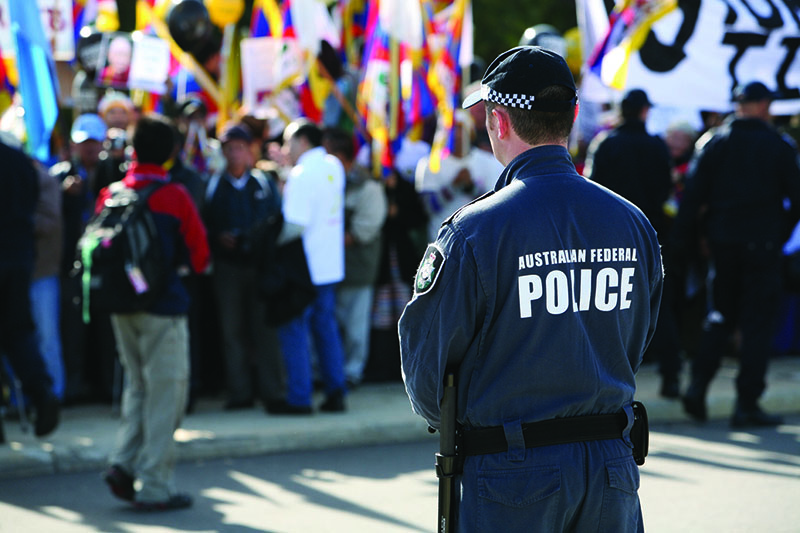Australia has a new counter-terrorism (CT) and counter-violent extremism (CVE) strategy – but it’s light on counter-terrorism and lacking in strategy. While it introduces two new CVE measures, it presents itself more as a communicative document than a real strategy or action plan.
The strategy will improve Australia’s early-intervention capacity. But it is a CVE strategy, not a CT strategy: it is focused on community intervention programs, not Australia’s capability to pre-empt or respond to terrorist acts.
Titled A Safer Australia – Australia’s Counter-Terrorism and Violent Extremism Strategy 2025, it was quietly released on 17 January, two years after the then Home Affairs Minister Clare O’Neil vowed to revise and update the strategy of 2022. Yet there is little to show for two years of development.
As of August 2024, Australia’s national terrorist threat level is ‘probable’ – higher than when the previous strategy was released. The document also arrives amid a spate of anti-Semitic incidents in Sydney and Melbourne and increasing political pressure on government to respond. Clearly, the title of ‘A Safer Australia’does not reflect our current security climate.
The strategy will improve Australia’s early-intervention capacity. But it is a CVE strategy, not a CT strategy: it is focused on community intervention programs, not Australia’s capability to pre-empt or respond to terrorist acts.
The document does not provide new CT policy, resourcing or strategic direction. A comprehensive strategy should address both.
Even on CVE it is light on policy ideas and specifics, supporting criticisms that the department has lacked in-house capability to lead on CT policy since the Australian Federal Police and the Australian Security Intelligence Organisation (ASIO) were moved outside it.
Lack of policy innovation
The strategy begins with a sober assessment of the threat landscape and focuses on countering rising youth violent extremism, as well as highlighting changes to the character of terrorism.
But these challenges – including hybrid ideologies and youth radicalisation – were discussed in 2024 by ASIO Director-General Mike Burgess in greater and more engaging detail.
The strategy also highlights the challenge of online spaces and radicalisation but commits only to closer collaboration with technology companies and partners.
It overlooks structural factors contributing to the rise of violent extremism.
It aims to prevent CVE at a community level through two main initiatives. Firstly, the Government intends to nearly double funding to state and territory partners for CVE intervention programs, which they lead, and commit to ongoing funding.
Secondly, it will establish a national version of the successful New South Wales Step Together program, a confidential, non-police community support service that parents can contact if they are concerned their child is radicalising. The Government will also better include young people in developing CVE policy.
These will not address the drivers of youth extremism, including real and perceived grievances. The strategy also highlights the challenge of online spaces and radicalisation but commits only to closer collaboration with technology companies and partners.
It overlooks structural factors contributing to the rise of violent extremism. More funding and a federal helpline are positives but are small offerings after two years of delay.
Instead of policy innovation, the strategy repeatedly refers to existing measures and “improving partnerships and collaboration” with various stakeholders. It rarely provides examples of how it will do this.
For instance, when announcing the strategy, Home Affairs Minister Tony Burke highlighted an ongoing commitment to engaging Southeast Asian partners – an important measure that already exists.
The strategy introduces no mechanisms for engagement or deepening relationships. Instead, it references the 2022 ASEAN-Australia Counter-Terrorism Dialogue.
Meeting the challenge
For CT, the strategy is seemingly more focused on communications than action, saying in its executive summary: “The Strategy is for all Australians to develop a greater understanding of the evolving threat and what Australian governments are doing to respond to those challenges.”
Transparency and communication with the public are important, but they are not a strategy. Furthermore, the Government is hardly promoting transparency by releasing the document with little notice on a Friday in mid-January.
Instead of foreshadowing new initiatives, the document commits to improved bureaucracy and internal functions, recommending improved internal assessment pathways and better consultation.
A real CT and CVE strategy requires new policy, more specifics and clear objectives. An increasingly difficult operational environment demands innovative policy backed by expertise.
Its action plan calls for yet another government review into existing frameworks. After a considerable wait for this strategy, it calls for more waiting.
Instead of new initiatives, it explicitly defends the status quo, saying “our current system for preventing and responding to terrorism is mature and works effectively”.
Certainly, Australia’s national security professionals at the coalface have an excellent record. But such confidence in the system contradicts reporting from September 2024 of a breakdown in collaboration between the federal government and the states and territories over the National Counter-Terrorism Plan – describing the situation as an unprecedented ‘clusterf–k’.
A key issue highlighted was the Home Affairs limited capacity to deliver counter-terrorism policy, with migration absorbing significant time and resources. Similar issues were raised by ASPI’s Justin Bassi and John Coyne in August, with the division of counter-terrorism responsibility between Home Affairs and the Attorney-General’s Department splitting expertise.
A real CT and CVE strategy requires new policy, more specifics and clear objectives. An increasingly difficult operational environment demands innovative policy backed by expertise. Terrorism is evolving and the threat it poses is increasing. Policy and resourcing need to be commensurate with this challenge.
This article first appeared on the ASPI Strategist website, and is republished under a Creative Commons Licence; you can read the original here.
About the Author
 Henry Campbell is the Strategic Engagement and Program Manager of ASPI’s National Security Programs, and has authored a range of articles in ASPI’s The Strategist across critical minerals, counter-terrorism, strategic policing, sports diplomacy, and Russian politics. Henry has also co-authored submissions and provided evidence to the Parliamentary Joint Committee on Intelligence Services and the Senate Legal and Constitutional Affairs References Committee. He holds a Bachelor of International Security Studies from the Australian National University and has previous experience managing resettlement programs for young migrants and refugees in Canberra, ACT.
Henry Campbell is the Strategic Engagement and Program Manager of ASPI’s National Security Programs, and has authored a range of articles in ASPI’s The Strategist across critical minerals, counter-terrorism, strategic policing, sports diplomacy, and Russian politics. Henry has also co-authored submissions and provided evidence to the Parliamentary Joint Committee on Intelligence Services and the Senate Legal and Constitutional Affairs References Committee. He holds a Bachelor of International Security Studies from the Australian National University and has previous experience managing resettlement programs for young migrants and refugees in Canberra, ACT.
Picture © Australian Federal Police Association


